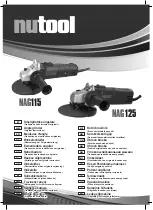
GB
- 19 -
5.2 Adjusting and replacing the guard (Fig. 3)
Warning!
•
Switch off the tool. Pull the power plug.
•
Adjust the guard (4) to protect your hands
so that the material being ground is directed
away from your body.
•
The position of the guard (4) can be adjusted
to any specific working conditions. Undo the
clamp handle (a) and turn the cover (4) into
the required position.
•
Ensure that the guard (4) correctly covers the
gear wheel casing.
•
Secure the clamp handle (a) again.
•
Ensure that the guard (4) is secure.
•
To replace the guard, remove the two flanges
and slacken the clamping lever (a) until the
guard can be removed.
•
To fit, proceed in reverse order.
Take care that the safety device is secure.
Never use the angle grinder without the gu-
ard.
5.3 Test run for new grinding Wheels
Allow the right-angle grinder to run in idle for at
least 1 minute with the grinding or cutting wheel
fi
tted in place. Vibrating wheels are to be replaced
immediately.
6. Operation
6.1. Switch (Fig. 4)
The angle grinder comes with a safety switch
which is designed to prevent accidents. To start,
push the locking lever (a) forwards, then press the
On/O
ff
switch (2).
6.1.1 Speed controller (Fig. 5)
You can select the speed by turning the speed
controller (6).
Switch position 1: approx. 3,000 rpm
Switch position 2: approx. 6,000 rpm
Switch position 3: approx. 8,000 rpm
Switch position 4: approx. 9,800 rpm
Switch position 5: approx. 10,500 rpm
Switch position 6: approx. 12,000 rpm
The best speed depends on the area of appli-
cation and the maximum rated speed of the
grinding/sanding tool. Select a speed in the range
from 3,000 to 12,000 rpm using the speed control
switch (6). You can choose from 6 di
ff
erent switch
positions. The speeds in the various switch posi-
tions are as follows:
Plus direction:
Higher speed
Minus direction:
Lower speed
6.1.2 Status indicator (Fig. 1)
The status indicator (7) lights up when the power
plug is connected.
Wait until the machine has reached its top
speed. You can then position the angle grin-
der on the workpiece and machine it.
6.2 Changing the grinding wheels (Fig. 6 / 7)
Use the face spanner (5) supplied to change the
grinding wheels. The face spanner (5) is stored in
the additional handle (3). Pull the face spanner (5)
out of the additional handle (3) when you need it.
Important!
For safety reasons, the angle grinder
must not be operated with the face spanner (5)
inserted in it.
Warning! Pull out the power plug.
•
Simple wheel change by spindle lock:
•
Press the spindle lock and allow the grinding
wheel to latch in place.
•
Open the flange nut with the face spanner.
•
(Fig. 7)
•
Change the grinding or cutting wheel and
tighten the flange nut with the face spanner.
Notice!
Only ever press the spindle lock when the
motor and grinding spindle are at a stand-
still! You must keep the spindle lock pressed
while you change the wheel!
For grinding or cutting wheels up to approx. 3 mm
thick, screw on the
fl
ange nut with the
fl
at side
facing the grinding or cutting wheel.
6.3 Flange arrangements when using
grinding wheels and cutting wheels
(Fig. 8-11)
•
Flange arrangement when using a de-
pressed-centre or straight grinding wheel
(Fig. 9)
a) Clamping flange
b) Flange nut
•
Flange arrangement when using a de-
pressed-centre cutting wheel (Fig. 10)
a) Clamping flange
b) Flange nut
•
Flange arrangement when using a straight
Anl_TE_AG_125_CE_SPK9.indb 19
Anl_TE_AG_125_CE_SPK9.indb 19
15.02.2018 13:24:09
15.02.2018 13:24:09
















































